
Hydra is the largest of the 88 modern constellations, measuring 1303 square degrees, and also the longest at over 100 degrees. Its southern end borders Libra and Centaurus and its northern end borders Cancer. It was included among the 48 constellations listed by the 2nd century astronomer Ptolemy. Commonly represented as a water snake, it straddles the celestial equator.

NGC 404 is a field galaxy located about 10 million light years away in the constellation Andromeda. It was discovered by William Herschel in 1784, and is visible through small telescopes. NGC 404 lies just beyond the Local Group and does not appear gravitationally bound to it. It is located within 7 arc-minutes of second magnitude star Mirach, making it a difficult target to observe or photograph and granting it the nickname "Mirach's Ghost".

NGC 3115 is a field lenticular (S0) galaxy in the constellation Sextans. The galaxy was discovered by William Herschel on February 22, 1787. At about 32 million light-years away from Earth, it is several times bigger than the Milky Way. It is a lenticular (S0) galaxy because it contains a disk and a central bulge of stars, but without a detectable spiral pattern. NGC 3115 is seen almost exactly edge-on, but was nevertheless mis-classified as elliptical. There is some speculation that NGC 3115, in its youth, was a quasar.

NGC 2683 is a field spiral galaxy in the northern constellation of Lynx. It was nicknamed the "UFO Galaxy" by the Astronaut Memorial Planetarium and Observatory. It was discovered by the astronomer William Herschel on February 5, 1788.

NGC 2903 is an isolated barred spiral galaxy in the equatorial constellation of Leo, positioned about 1.5° due south of Lambda Leonis. It was discovered by German-born astronomer William Herschel, who cataloged it on November 16, 1784. He mistook it as a double nebula, as did subsequent observers, and it wasn't until the nineteenth century that the Third Earl of Rosse resolved into a spiral form. J. L. E. Dreyer assigned it the identifiers 2903 and 2905 in his New General Catalogue; NGC 2905 now designates a luminous knot in the northeastern spiral arm.

NGC 5754 is a barred spiral galaxy located 218 million light years away in the constellation Boötes. It is a member of the Arp 297 interacting galaxies group, which consists of NGC 5752, NGC 5753, NGC 5754, NGC 5755. Along with NGC 2718 and UGC 12158, NGC 5754 is often considered a Milky Way-twin.
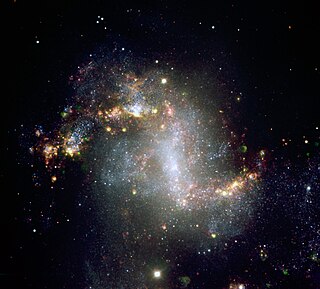
NGC 1313 is a field galaxy and a barred spiral galaxy discovered by the Scottish astronomer James Dunlop on 27 September 1826. It has a diameter of about 50,000 light-years, or about half the size of the Milky Way.
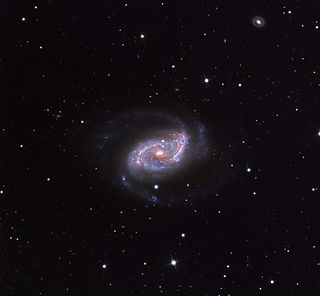
NGC 5248 is a compact intermediate spiral galaxy about 59 million light-years away in the constellation Boötes. It is a member of the NGC 5248 Group of galaxies, itself one of the Virgo III Groups strung out to the east of the Virgo Supercluster of galaxies. Distance measurements to NGC 5248 vary from 41.4 million light-years to 74.0 million light-years, averaging about 58.7 million light-years.

NGC 6503 is a field dwarf spiral galaxy located at the edge of a region of space called the Local Void. The dwarf galaxy spans 30,000 light-years and lies approximately 17 million light-years away in the constellation of Draco. The spiral galaxy is especially colorful where bright red regions of gas can be seen scattered through its spiral arms. Bright blue regions contain stars that are forming. Dark brown dust areas are in the galaxy's arms and center.
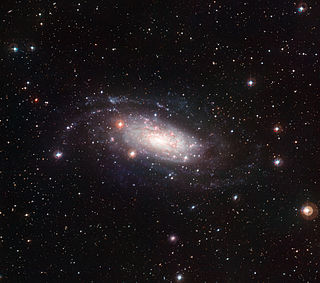
NGC 3621 is a field spiral galaxy about 22 Mly (6.7 Mpc) away in the equatorial constellation of Hydra. It is comparatively bright and can be well seen in moderate-sized telescopes. The galaxy is around 93,000 ly (29,000 pc) across and is inclined at an angle of 25° from being viewed edge on. It shines with a luminosity equal to 13 billion times that of the Sun. The morphological classification is SA(s)d, which indicates this is an ordinary spiral with loosely wound arms. There is no evidence for a bulge. Although it appears to be isolated, NGC 3621 belongs to the Leo spur.

NGC 125 is a lenticular galaxy located in the constellation Pisces. It is designated as subclass Sa Ring in the galaxy morphological classification scheme. It lies approximately 235 million light-years away.

NGC 7080 is a barred spiral galaxy located about 204.5 million light-years away in the constellation of Vulpecula. It has an estimated diameter of about 100,000 light-years which would make it similar in size to the Milky Way. NGC 7080 was discovered by astronomer Albert Marth on September 6, 1863.

NGC 4503 is a barred lenticular galaxy located around 41 to 74 million light-years away in the constellation Virgo. NGC 4503 was discovered by astronomer William Herschel on March 15, 1784. NGC 4503 is a member of the Virgo Cluster.

NGC 5084 is a lenticular galaxy in the constellation of Virgo. It is located at a distance of about 80 million light years from Earth, which, given its apparent dimensions, means that NGC 5084 is at least 200,000 light years across. It is one of the largest and most massive galaxies in the Virgo Supercluster. William Herschel discovered it on March 10, 1785. It is a member of the NGC 5084 Group of galaxies, which is a member of the Virgo II Groups, a series of galaxies and galaxy clusters strung out from the southern edge of the Virgo Supercluster. The galaxy is seen nearly edge-on, with inclination 86°, and features a warped disk and large quantities of HI gas extending along the disk, probably accumulated after multiple accretions of smaller galaxies.
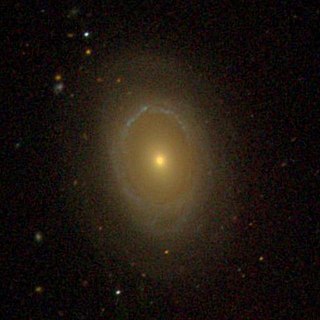
NGC 3884 is a spiral galaxy located about 330 million light-years away in the constellation Leo. The galaxy was discovered by astronomer William Herschel on April 27, 1785 and is a member of the Leo Cluster.

NGC 2835 is an intermediate spiral galaxy located in the constellation Hydra. It is located at a distance of circa 35 million light years from Earth, which, given its apparent dimensions, means that NGC 2835 is about 65,000 light years across. It was discovered by Wilhelm Tempel on April 13, 1884. NGC 2835 is located only 18.5 degrees from the galactic plane.
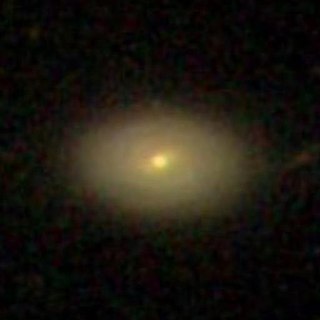
NGC 4060 is a lenticular galaxy located 320 million light-years away in the constellation Coma Berenices. It was discovered by astronomer Albert Marth on March 18, 1865 and is a member of the NGC 4065 Group which is part of the Coma Supercluster.

NGC 1325 is a flocculent spiral galaxy situated in the constellation of Eridanus. Located about 75 million light years away, it is a member of the Eridanus cluster of galaxies, a cluster of about 200 galaxies. It was discovered by William Herschel on 19 December 1799.

NGC 3937 is an elliptical or a lenticular galaxy located about 310 million light-years away in the constellation Leo. It was discovered by astronomer William Herschel on April 27, 1785 and is classified as a radio galaxy.

NGC 3435 is a barred spiral galaxy located about 235 million light-years from the Milky Way, and is about 125 000 light-years across. It can be found in the constellation Ursa Major. It was discovered on 9 April 1793 by astronomer William Herschel.




















